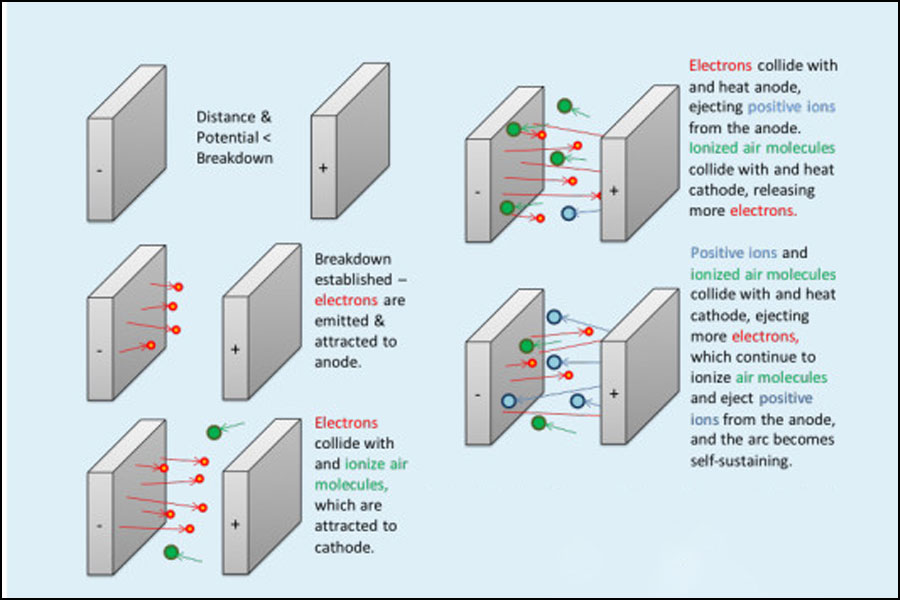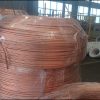
In general, dielectric materials do not allow current to pass through them, even when there is a potential (voltage) between them. This is the definition of electrical insulators. However, all materials will eventually conduct electricity if the application potential is large enough. This process occurs called dielectric breakdown.
The potential value at which this happens is called the breakdown voltage (in volts). The dielectric strength is in this situation (units: volts/meter, kilovolts/mm, etc.). The difference is important, because the fault is for thicker materials, the voltage will be greater, and for thinner materials, the dielectric strength (theoretically) remains the same. Therefore, the dielectric strength is more like a material property, and the breakdown voltage is more like a system property.
As early as 2012, the 40th issue of the technical tabloid was published. Discussed the arc between electrical contacts. To sum up, when the potential is between the oppositely charged contacts, the voltage will break down the distance between the contacts, and the electrons have enough energy to escape the cathode and move to the anode. Along the way, electron collisions make contact between charged gas molecules and ionized gas molecules, producing more free electron anodes. At the same time, positive ions are attracted to the cathode and move toward it. As ions and electrons collide with the contact, the contact is heated to emit more ions and electrons in a positive feedback process. Electrons will flow through this arc until the voltage and/or current are below a critical threshold and the arc is extinguished.

Figure-1-Arc-start-in-air.
This provides a detailed description of when the two halves of the connector are connected together under sufficient voltage to initiate the electrical breakdown of the gap and the subsequent arcing.
Even in a theoretically perfect vacuum, with enough potential, the electrons in the cathode will have enough energy to cross from the cathode to the anode.
There are similar processes in dielectric materials. Breakdown usually occurs in internal voids, holes, or other defects in the material. These are usually filled with gas. When the entire material is under a potential gradient, the sides of the dielectric air bag will have different charges. AT sufficiently high potential gradient, internal arcs will be formed in the dielectric material passing through these voids. The dielectric insulation is embodied as a conductor.
This process has several consequences. One is that its manufacturing quality materials (such as the number and size of voids, internal contamination and similar defects) will affect its actual dielectric strength. The other is that the dielectric strength of the material is always low. Greater than the maximum theoretical value. Different batches of dielectric have different strengths.
Another consequence is the process of failure. If the applied field is removed before the failure starts, there will be no failure. Therefore, a larger short-term start-up failure gradient is required to be easier to expose than steady-state exposure. Therefore, even the frequency of the applied electric field affects the dielectric strength.
Corona is a dielectric material. Sharp corners or edges concentrate the electric field in that place. This enhanced field has the potential to 1) ionize surrounding air molecules. This is the physical phenomenon of the mechanism responsible for the Saint Elmo fire, not the 80s movie, and if you get stuck with the theme song now, I’m sorry in your mind). The fire of Saint Elmo is the brilliance that occurs on top of a tall and pointed object like a ship’s mast when a thunderstorm comes. The advantage of this effect of lightning rods is to use charge concentration at the top of the pole to provide a simple and clear grounding path that bypasses critical structures.
Air molecules ionized by the corona will be able to charge and discharge in a process called corona. Note that corona discharge is another method of possible failure in the gap in the dielectric. Corona discharge is affected by applied voltage, dielectric shape, atmospheric composition and humidity.
When testing the dielectric strength of a material, it is important to pay attention to how the field is applied, because the strength will vary with the electrode, as well as the dielectric. Even the surrounding air and its relative humidity will have an impact.






